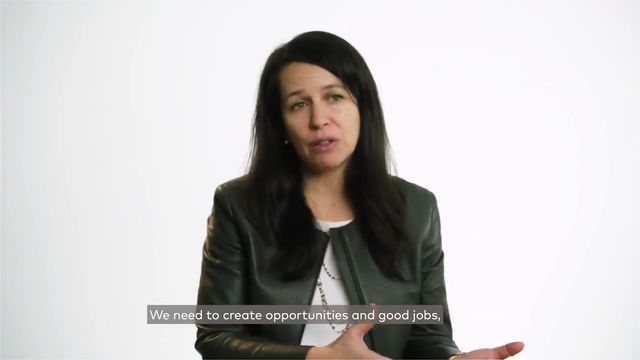Realism About Reskilling
Learn about new research from the Brookings’ Workforce of the Future initiative on upgrading the career prospects of America’s low-wage workers.
Every person deserves the opportunity for dignified employment that provides living wages and potential for advancement. However, for many in America today, this is far from reality, as they are caught in a cycle of low-wage work, earning poverty wages and unable to move up in the economy.
Local leaders, firms and workers need to adapt quickly to keep pace with rapid technological innovation and its transformative impact on the U.S. economy. Using reskilling as a focal point, this report aims to provide policymakers with tools to do so by answering the following questions:
Who are the nation’s low-wage workers, and what are their prospects?
We provide a detailed demographic analysis of America’s low-wage workers and pair it with national labor market projections to understand their place in the changing world of work.
Where are the local opportunities for mobility, and how can policymakers expand them and help low-wage workers transition?
We develop a “near-term mobility index” and use it to identify the low-wage occupations offering opportunities for upward mobility.
How can the reskilling infrastructure adapt to the future, foster inclusion, and address the needs of any worker seeking upward mobility?
We pair a landscape analysis of the American reskilling system with a proposed “end-to-end reskilling journey” —a six-part framework that policymakers can use to build reskilling infrastructure that leaves no one behind.
Only by designing programs that alleviate the barriers and friction points people face in their reskilling journey, can the reskilling infrastructure truly foster inclusion.
Upgrading the career prospects of America’s 53 million low-wage workers will not mean the end of low-wage work. The policy goal is for low-wage work to be a springboard, not a trap. Realizing this vision will be no small feat. But with tight labor markets, a steadily growing economy and accelerating demand for new skills, the time for deep institutional change is now.
This research is directed toward several key players:
Employers, who have as much to gain from skilled and motivated employees as they have to offer in specific knowledge.Leaders in skilling organizations (both public and private) and higher education, who know what works and can collaborate to deliver scale and market relevance.Policymakers, who must lead the effort to reduce the precarity of low-wage work and deliver opportunity to anyone who wants it.
To find answers, we start with the scale and pervasiveness of the problem — stagnant and unpromising low-wage work is prolific and deepening, and though it affects some more than others, the phenomenon of churning through low-wage, low-mobility jobs pervades all ages, demographics and educational backgrounds. For many, the intersection of their identities and life experiences makes the prospects for mobility especially dim. An inclusive lifelong learning infrastructure that meets workers where they are can help break the cycle.
Rapid technological innovation and big data, two drivers splitting our economy, can be leveraged as a solution, too. Analytical insights on companies’ in-house talent pools have the potential to increase the amount and quality of training. Knowledge of in-demand jobs can help skilling organizations and universities see around the corner to deliver content that produces positive market outcomes. These insights have to be locally relevant and forward-looking, and must avoid reproducing systemic biases.
Armed with such information, workforce development efforts can more efficiently and nimbly adapt to the needs of workers and firms. Properly aligned with economic development, such interventions can work in concert for amplified impact on workers’ local opportunity. By engaging, coordinating and nudging firms, policymakers can improve job quality while catalyzing wage growth. However, only by designing programs that alleviate the barriers and friction points people face in their reskilling journey, can the reskilling infrastructure truly foster inclusion. With anything less, the accelerating demand for high-paying digital skills will lock in existing disadvantages and continue to widen socioeconomic divisions.
Chapter 1 summarizes the forces and policies that are reducing mobility and job quality in the United States while increasing economic insecurity through the proliferation of low-wage work.
Chapter 2 uses data from the American Community Survey to estimate the population of low-wage workers — a staggering 53 million people — to understand their demographic characteristics and geographical dispersion.
Chapter 3 uses the Current Population Survey and Bureau of Labor Statistics data to examine how labor market dynamics shape the way low-wage workers move within and between occupations in a shifting job market. It develops a near-term mobility index that ranks occupations based on the economic prospects of workers transitioning out of them. It pairs the index with projections of local occupational growth to show how city planners can invest in key industries and design programs that provide workers with realistic opportunities for upward transitions.
Chapter 4 introduces the “End-to-end reskilling journey,” a framework to design and analyze programs from the perspective of the worker or learner.
Combined with Brookings previous report, Growing Cities That Work for All, this report illustrates the trends affecting low-wage work and the implications for leaders aiming to improve worker mobility.
Click here for the full report.
The Brookings’ Workforce of the Future initiative is supported by a grant from the Mastercard Impact Fund and Google.org. The Center collaborates actively with scholars and researchers analyzing how to improve inclusive growth in cities so as to attract vibrant industries and create good jobs.



